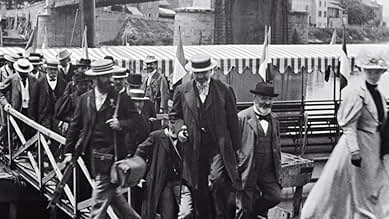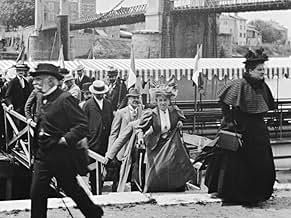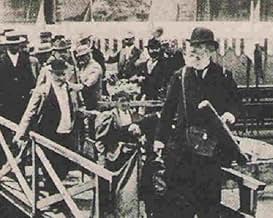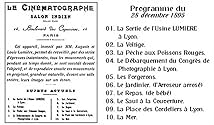IMDb RATING
5.7/10
2.1K
YOUR RATING
The photographers who need to participate in the congress of Lyon get off a boat in Neuville-sur-Saône, dividing to the right and left.The photographers who need to participate in the congress of Lyon get off a boat in Neuville-sur-Saône, dividing to the right and left.The photographers who need to participate in the congress of Lyon get off a boat in Neuville-sur-Saône, dividing to the right and left.
- Director
- Stars
P.J.C. Janssen
- Self
- (uncredited)
Featured reviews
To many historians, December 28, 1895, is the date considered as the day where cinema was born, as it was in that cold day of winter when the brothers Auguste and Louis Lumière gave the first public screening of their new invention, the Cinématographe. The brothers' devise would change history of entertainment forever, as it took the idea of motion pictures from the uncomfortable and individual experience of Edison's Kinetoscope, to the more enjoyable atmosphere of a movie projected on a screen. On that day the brothers showed 10 films, and the majority of them were of the kind that later would be known as "actuality films", movies showing an everyday event. However, one of the 10 films was a bit more than a typical "actuality film", as it was actually the register of an event in a fashion more akin to what we know now as documentary films: it was the arrival of the Photographical Congress to Lyon.
While December 28, 1895, was certainly the very first time the brothers showed their invention to the world, it wasn't really the first time the brothers' invention was shown to an audience, as months earlier, the brothers had been doing private screenings for the scientific community of France. The 1895 Photographical Congress that was celebrated at the community of Neuville-sur-Saône in Lyon, was one of the places where the Lumières screened their films for the first time. "Neuville-sur-Saône: Débarquement du congrès des photographes à Lyon", is essentially the recording of the arrival of the members of the Photographical Congress to Neuville-sur-Saône, marking the first time a camera was used to capture something more "special" than people moving or trains arriving. This time the new medium was being used to actually register the event in real time, pretty much in the same way as TV News work today.
Nevertheless, that was not the only thing that "Neuville-sur-Saône" an interesting early short film. The movie was shot when the Congress arrived, early in the morning, and that very same day was shown to its protagonists in the afternoon. One has to wonder how the photographers felt when they saw the images of their arrival actually moving, as if the even was being enacted again. The very same people that looked into the camera (perhaps thinking it was a normal photography) was now watching themselves in a motion picture depicting short seconds of their lives. It was certainly a unique experience, and no doubt the success of "Neuville-sur-Saône: Débarquement du congrès des photographes à Lyon" and their other films that day prompted the brothers to keep working in their preparation for that December day, when the world witnessed what a group of photographers did (and saw) months ago. 7/10
While December 28, 1895, was certainly the very first time the brothers showed their invention to the world, it wasn't really the first time the brothers' invention was shown to an audience, as months earlier, the brothers had been doing private screenings for the scientific community of France. The 1895 Photographical Congress that was celebrated at the community of Neuville-sur-Saône in Lyon, was one of the places where the Lumières screened their films for the first time. "Neuville-sur-Saône: Débarquement du congrès des photographes à Lyon", is essentially the recording of the arrival of the members of the Photographical Congress to Neuville-sur-Saône, marking the first time a camera was used to capture something more "special" than people moving or trains arriving. This time the new medium was being used to actually register the event in real time, pretty much in the same way as TV News work today.
Nevertheless, that was not the only thing that "Neuville-sur-Saône" an interesting early short film. The movie was shot when the Congress arrived, early in the morning, and that very same day was shown to its protagonists in the afternoon. One has to wonder how the photographers felt when they saw the images of their arrival actually moving, as if the even was being enacted again. The very same people that looked into the camera (perhaps thinking it was a normal photography) was now watching themselves in a motion picture depicting short seconds of their lives. It was certainly a unique experience, and no doubt the success of "Neuville-sur-Saône: Débarquement du congrès des photographes à Lyon" and their other films that day prompted the brothers to keep working in their preparation for that December day, when the world witnessed what a group of photographers did (and saw) months ago. 7/10
Considering that the Photographical Congress arriving in Lyon was a major event, I suppose you could call this one more important than the Lumiere Brothers' previous efforts because the event is something that most people wouldn't see a lot of the time. This film captures simply what the title suggests: a whole crowd of photographers coming off a ferry. Indeed quite a few of the photographers notice the camera and while some tip their hats in greeting, others notice the camera and refuse to be part of the film by dashing off the screen quickly.
At only a minute watching, this short documentary isn't a waste of time. It will probably only be interesting to people like me who, believe it or not, somehow find entertainment in watching these things. Audiences nowadays will find it pretty uninteresting--except for if you're a historian. In that case it's a must-see.
At only a minute watching, this short documentary isn't a waste of time. It will probably only be interesting to people like me who, believe it or not, somehow find entertainment in watching these things. Audiences nowadays will find it pretty uninteresting--except for if you're a historian. In that case it's a must-see.
Louis Lumiere sets his camera's sight on other filmmakers. As they exit the boat at Lyon, the attendees greet the camera. August Lumiere is one of the people filmed. As the people filmed were attending the Photographical Congress, they must have appreciated the camera set up before them. Some greet it, while others duck quickly out of the way.
The Lumieres were keen on filming everyday life. They wanted to record everyday moments in normal life. We are able to witness the styles of dress as well as the mannerisms of the people in the late nineteen hundreds.
YOU WILL LIKE THIS FILM, IF YOU LOVED: "Employees Leaving the Lumiere Factory" IF YOU HATED: "The Execution of Mary, Queen of Scots"
The Lumieres were keen on filming everyday life. They wanted to record everyday moments in normal life. We are able to witness the styles of dress as well as the mannerisms of the people in the late nineteen hundreds.
YOU WILL LIKE THIS FILM, IF YOU LOVED: "Employees Leaving the Lumiere Factory" IF YOU HATED: "The Execution of Mary, Queen of Scots"
This interesting footage is particularly worth seeing as a companion piece to, and as a comparison with, the Lumière classic, "La Sortie des usines Lumière". The two features have much in common, and they are interesting for many of the same reasons.
In both movies, there is a rather sizable crowd moving towards the camera, knowing that they are being filmed. The main difference is that this movie features professional photographers, as they arrive to attend a congress of a photographic society. Their reactions are largely the same as were those of the factory workers, but many of the "professionals" seem more determined to hide their curiosity. On the other hand, a number of them show their interest even more eagerly, tipping their hats in a particularly jaunty fashion, demonstrating a bit of showmanship of their own.
As with the footage of the factory workers, the motion towards the camera is effective, and here the background scenery also has some interesting details. This film is also self-referential in one interesting respect, since the subjects of the film were also its initial audience. It's all rather interesting to take in.
In both movies, there is a rather sizable crowd moving towards the camera, knowing that they are being filmed. The main difference is that this movie features professional photographers, as they arrive to attend a congress of a photographic society. Their reactions are largely the same as were those of the factory workers, but many of the "professionals" seem more determined to hide their curiosity. On the other hand, a number of them show their interest even more eagerly, tipping their hats in a particularly jaunty fashion, demonstrating a bit of showmanship of their own.
As with the footage of the factory workers, the motion towards the camera is effective, and here the background scenery also has some interesting details. This film is also self-referential in one interesting respect, since the subjects of the film were also its initial audience. It's all rather interesting to take in.
Neuville-sur-Saône: Débarquement du congrès des photographes à Lyon (1895)
The title of this Lumiere Brothers film pretty much tells you what you're looking at. We see a group of people walking off a riverboat and coming close to the camera who catches their every move. There's certainly nothing ground-breaking about this early "actuality" movie but if you're a fan of these then you're bound to enjoy this one. I always enjoy watching these because it gives you a great chance to see how things were so many years ago. This one here features a lot of people so you get a terrific idea of the type of clothing that was worn during this period as well as a chance to see the various other things going on. This here is well worth watching if you enjoy these movies.
The title of this Lumiere Brothers film pretty much tells you what you're looking at. We see a group of people walking off a riverboat and coming close to the camera who catches their every move. There's certainly nothing ground-breaking about this early "actuality" movie but if you're a fan of these then you're bound to enjoy this one. I always enjoy watching these because it gives you a great chance to see how things were so many years ago. This one here features a lot of people so you get a terrific idea of the type of clothing that was worn during this period as well as a chance to see the various other things going on. This here is well worth watching if you enjoy these movies.
Did you know
- ConnectionsEdited into The Lumière Brothers' First Films (1996)
Details
- Release date
- Country of origin
- Language
- Also known as
- Arrivée des congressistes à Neuville-sur-Saône
- Filming locations
- Production company
- See more company credits at IMDbPro
- Runtime
- 1m
- Color
- Sound mix
- Aspect ratio
- 1.33 : 1
Contribute to this page
Suggest an edit or add missing content









